Boho vs. Bohemian: Unveiling the Distinct Differences in Interior Design
Many people often use the terms “Boho” and “Bohemian” interchangeably, believing them to be synonymous or that “Boho” is merely a shortened version of “Bohemian.” While both styles embrace a free-spirited, unconventional aesthetic, they possess distinct origins, characteristics, and design philosophies that set them apart. Understanding these nuances is key to truly appreciating and effectively implementing either style in your home.
Traditionally, the term ‘Boho’ refers to interior decor and fashion styles rooted in the late 18th and 19th centuries, reflecting a particular historical era. In contrast, ‘Bohemian’ as a modern design concept, often referred to as ‘Boho-Chic,’ gained prominence much later, primarily after the 1970s. This distinction means that while Boho leans into vintage, expressive elements, modern Bohemian styles offer a more contemporary, sometimes minimalist, approach to free-spirited living.
Before we delve deeper into this captivating comparison, consider exploring our insights on earthy Boho kitchen ideas to establish a foundational understanding of one aspect of this diverse design world.
In this comprehensive guide, we will unveil the major differences between pure Boho and modern Bohemian (Boho-Chic) interior design styles, helping you identify which aesthetic resonates most with your personal taste and lifestyle.
Boho vs. Bohemian: A Detailed Comparison
While sharing a common root in non-conformity and artistic expression, Boho and Bohemian interior design styles diverged significantly over time. Let’s explore their core differences.
1. Origin and Evolution of Both Styles
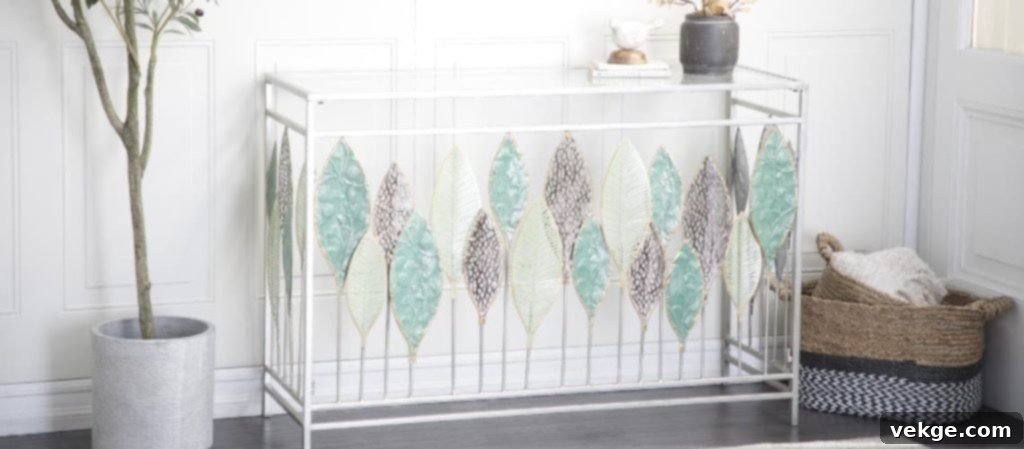
The original ‘Boho’ interior design styles, often referred to simply as “Bohemian” in its historical context, emerged during the late 18th and 19th centuries in Europe. This aesthetic was adopted by artists, writers, intellectuals, and free spirits who rejected bourgeois conventions, embracing a nomadic, unconventional lifestyle. The term “Bohemian” itself was coined from the French word for the Romani people, who were believed to originate from Bohemia (modern-day Czech Republic) and were associated with a wandering, artistic existence. This early style was a rebellion, characterized by thrift store finds, collected treasures from travels, vibrant colors, and a maximalist, lived-in feel.
Fast forward to the latter half of the 20th century, particularly after the 1970s, and we see the rise of what is now commonly referred to as ‘Bohemian’ or, more precisely, ‘Boho-Chic.’ This modern iteration draws heavily from the original bohemian ethos but integrates contemporary sensibilities. Influenced by the hippie movement, global travel, and a growing appreciation for craftsmanship, Boho-chic blends the free-spirited nature of its predecessor with more refined, curated, and sometimes minimalist design techniques. It’s less about rebellion and more about self-expression, comfort, and a relaxed, yet stylish, environment.
2. Styling Elements and Overall Aesthetic
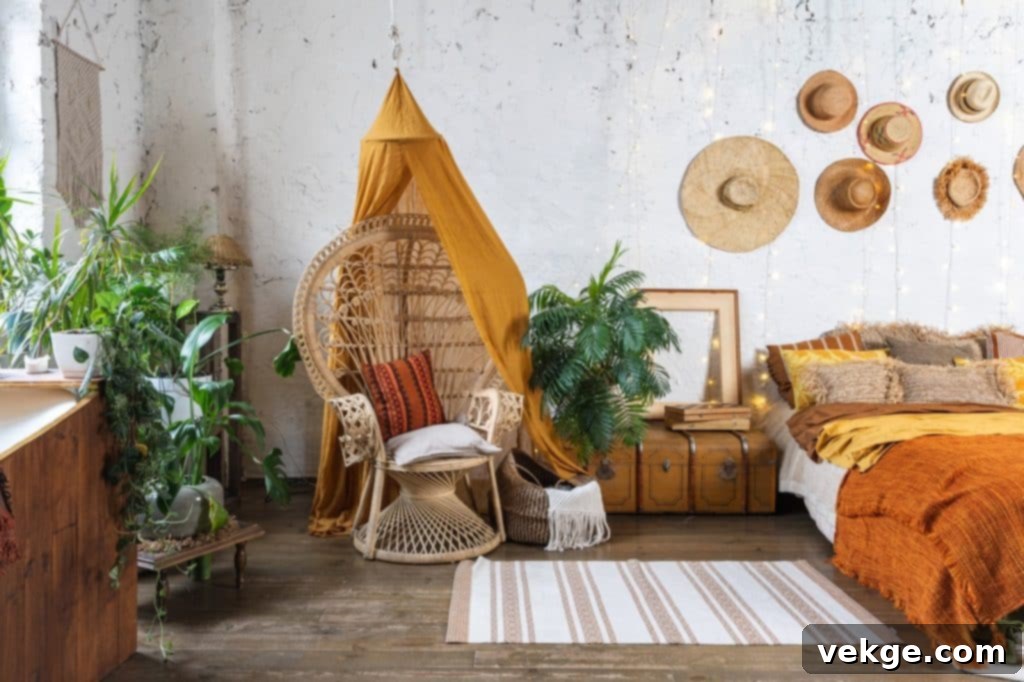
Authentic Boho styles revel in vintage elements, creating a profoundly expressive and often eclectic interior. Think of a collected, ‘found’ aesthetic where items tell a story. Colors are often rich and deeply saturated, textures are varied, and patterns are bold, creating a romantic and visually stimulating display. Interior designers embracing traditional Boho use techniques that evoke a sense of freedom and artistic flair. Cushions, furniture, sofas, and bedspreads are typically a riot of colors and vibrant patterns, often mismatched but harmoniously arranged to create a cozy, well-traveled ambiance. This style thrives on a maximalist approach, with layers of textiles, art, and personal artifacts.
In contrast, modern Bohemian styles, or Boho-chic, present a more refined and curated version. While still embracing eclectic elements, there’s an emphasis on balance and a more deliberate selection of items. The decor items, whether cushion covers, furniture upholstery, or sofa sets, are often more cohesively fitted, suggesting a thoughtful arrangement rather than a spontaneous accumulation. Furniture accessories might be arranged in a more coordinated manner, and while global influences are present, they are often integrated with a cleaner, more contemporary edge. Above all, the color palettes in Bohemian-chic styling tend to be more neutral, providing a calm backdrop against which unique pieces can truly shine.
3. Natural Elements and Their Application
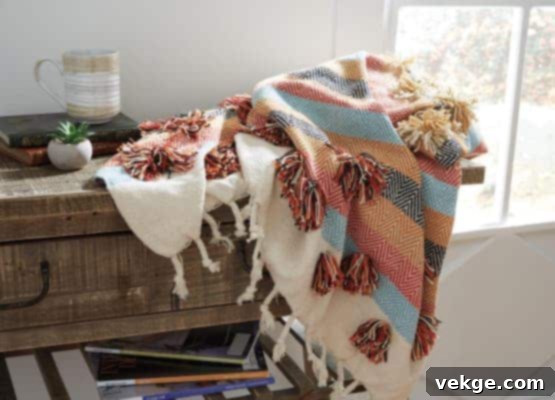
Interior designers who adhere to traditional Boho styles extensively incorporate raw, expressive natural elements to bring life and glamor to spaces. This often translates into a profusion of organic materials and elements: clay pottery, feathers, unpolished stones, and an abundance of potted plants create a lush, almost jungle-like feel. The intention is to blur the lines between indoor and outdoor, infusing living areas with vibrant, earthy tones and textures that celebrate nature in its most authentic form. Woven baskets, macrame wall hangings, rattan furniture, and wood with natural finishes are all staples.
Conversely, the Boho-chic style also embraces natural elements but often with a more minimalist and refined approach. While plants are still integral, they might be fewer in number but larger in scale, or more thoughtfully arranged. The “gradients” here refer to subtle transitions and a preference for natural textures within a more restrained color scheme. Grays, whites, and creams frequently dominate the wall decor in living rooms, dining areas, bedrooms, and bathrooms, serving as a serene backdrop. Natural materials like wood, jute, and linen are still prominent, but they might appear in cleaner designs or paired with more contemporary finishes. Elements like sophisticated geodes, polished stones, or subtle gemstone accents (like sapphires in furniture accessories, as mentioned) are often used to add a touch of understated luxury and organic beauty without overwhelming the space.
4. Colors, Textures, and Layers: A Visual Comparison
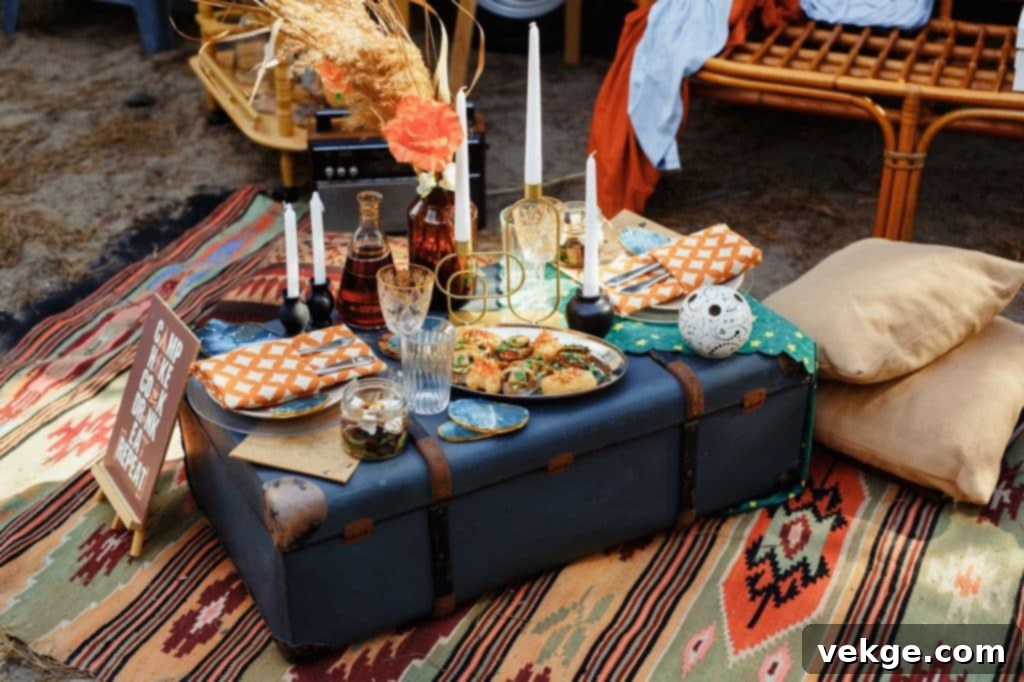
When it comes to colors, textures, and layers, the contrast between Boho and Bohemian-chic is quite stark. Traditional Boho styles are characterized by an exuberant use of color. The more colorful and vibrant the decor, the more it aligns with the original Boho aesthetic. This involves a rich tapestry of jewel tones like emerald green, sapphire blue, ruby red, and amethyst purple, often combined with earthy hues such as terracotta, mustard yellow, and deep orange. Textures are paramount, with a strong emphasis on layering diverse fabrics like velvet, silk, linen, and cotton. Think woven baskets, vintage-style Persian or Moroccan rugs layered over each other, intricate tapestries, and an abundance of potted plants. Artifacts or murals, often sourced from vintage antique stores or international travels, add to this rich, story-filled environment. The philosophy is ‘more is more,’ creating a sensory overload in the most delightful way.
In contrast, Bohemian-chic styles utilize a more restrained color palette, typically starting with monochromatic or neutral hues. Within an ambiance primarily defined by shades of gray, black, white, or cream, pops of color are introduced strategically. For instance, cream curtain blinds might seamlessly integrate into the wall decor, or a focal piece of art might be the sole source of vibrant color. Textures and layers are still crucial but are applied with a more refined hand. You might find chequered black-and-white designs for carpets, or minimalist, geometric patterns rather than elaborate ethnic prints. Furniture often features clean lines, and accessories like black-painted antique wall clocks become focal points, standing out against the neutral backdrop. The overall effect is sophisticated and tranquil, allowing individual, carefully selected pieces to make a statement without the visual clutter of traditional Boho.
5. Earthy Boho Kitchen Decor Example
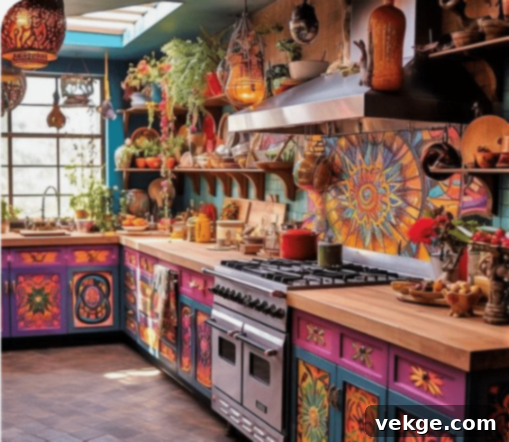
Imagine a kitchen bursting with life and color – this is the essence of an earthy Boho kitchen. The wall decor embraces a kaleidoscope of hues: vibrant greens, deep blues, rich purples, soft pinks, sunny yellows, and warm browns, creating an almost rainbow-like effect that makes the kitchen feel incredibly inviting and energetic. Wooden artifacts, such as intricately woven cane baskets, and an abundance of potted plants and trailing greens, are thoughtfully adorned throughout the space, bringing the outdoors in. Functionality is key, yet it’s integrated seamlessly with the aesthetics; the gas stove might sit perfectly between the kitchen counter and the sink, surrounded by collected pieces. To add an interesting contrasting vibe, a rustic wooden chopping board or display shelf might feature a more minimalist design, allowing its natural material to stand out amidst the colorful symphony. Every element feels organic, handcrafted, and tells a story of global adventures and a love for nature.
6. Bohemian-Chic Kitchen Decor Example

In stark contrast, a trendy Bohemian-chic kitchen and dining space presents a display of refined sophistication. Here, a monochromatic range of shades – predominantly browns, grays, and blacks – creates a sleek and modern foundation. Table lamps strategically adorn various spaces, providing ample, ambient lighting at night, highlighting specific features rather than bathing the entire room in bright light. A distinct architectural feature, such as a stylish exposed brick wall, might elegantly divide the kitchen sink area from the countertop, adding texture and character without introducing excessive color. A contemporary dining table with matching brown chairs creates a cohesive look, inviting comfortable gatherings. While still embracing nature, the greenery here is carefully selected and often presented in more modern planters, beautifying the space with a sense of curated abundance rather than wild abandon. Furthermore, elements like a sleek grill gate might allow an abundance of natural lighting into the dining-cum-kitchen hall, enhancing the airy and open feel, reinforcing the blend of natural elements with modern design principles.
Conclusion: Embracing Your Unique Aesthetic
We’ve thoroughly explored the nuanced differences between traditional Boho and modern Bohemian-chic design styles. The key takeaway is clear: while both celebrate individuality and a free-spirited approach to home decor, they manifest these ideals in distinct ways. Traditional Boho thrives on maximalism, an explosion of colors, diverse patterns, and a collection of items that tell a global story, embodying a rich, layered, and often vintage aesthetic. It’s a celebration of the “more is more” philosophy, where every item contributes to a vibrant, lived-in tapestry.
On the other hand, Bohemian-chic styles lean towards a more curated and refined aesthetic. They often employ a neutral base palette – think shades of gray, black, cream, and white – allowing carefully selected antique furniture pieces, global accents, and natural elements to stand out. The accessories are often more cohesively fitted, and the layering is more intentional, creating an uber-chic and sophisticated living environment that still feels warm and inviting. It’s about bringing together disparate elements into a harmonious, often minimalist, whole, reflecting a polished version of bohemian freedom.
The beauty of both styles lies in their adaptability and the emphasis on personal expression. You can easily incorporate DIY themes into either, whether it’s adding splash paints for a burst of color in a Boho room, including handmade jewel sets as elegant accents in a Boho-chic space, or decorating with unique murals or artifacts made from wood or ceramic. These personal touches can elevate any room, be it your living space, bedroom, bathroom, or kitchen-cum-dining unit.
Ultimately, choosing between Boho and Bohemian-chic, or even blending elements from both, comes down to your personal aesthetic and how you envision your ideal living space. Do you gravitate towards a vibrant, eclectic, and maximalist haven, or a refined, serene, and subtly sophisticated sanctuary? Which styling technique truly speaks to your soul? Do let us know!
